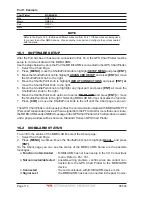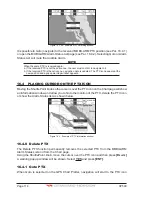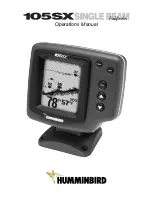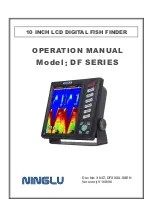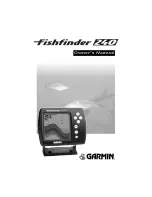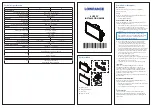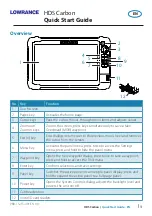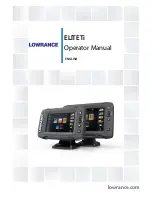
Page 100
CP590
RMA
Off
Off
Off
Off
Off
RMB
Off
Off
Off
Off
Off
RMC
On
On
On
On
On
GGA
On
On
On
On
On
HSC
Off
Off
Off
Off
Off
DBT
On
Off
Off
Off
Off
DPT
On
Off
Off
Off
Off
MTW
On
Off
Off
Off
Off
VHW
On
Off
Off
Off
Off
GSA
On
Off
Off
Off
Off
GSV
On
Off
Off
Off
Off
13.1 NAVIGATE
The Navigate menu allows customization of the Coordinate System (Loran TD's), Chart
Datum, Chart Orientation Resolution (angle the vessel has to change before the chart is
redrawn) and Static Navigation. See the following table:
Coordinate System
: Selections are:
a. TD: Time Difference, based on Loran (see the following Par. 13.1.0)
b. UTM: Universal Transverse Mercator Grid
c. ddd mm.mmm: Degrees Minutes and Thousands of Minutes
d. ddd mm.mm: Degrees Minutes and Hundredths of Minutes
e. ddd mm.ss: Degrees Minutes and Seconds
Chart Datum
: Allows selection of Chart Datums. The default Datum is WGS84 as C-MAP B
Y
J
EPPESEN
cartography has been compiled using the WGS84 Datum. A datum is a mathematical
model of the Earth which approximates the shape of the Earth, and enables calculations
such as position and area to be carried out in a consistent and accurate manner.
Chart Orientation Resolution
: Sets the angle the vessel has to change before the chart is redrawn. The default setting
is 30 degrees. Example: if the vessel is heading 000T at a speed of 25 Knots, the display
will redraw:
a. In Home mode the GPS Chart Plotter centers the location of the vessel in the center
of the display. To keep the vessel in the center of the display the GPS Chart Plotter
will occasionally redraw.
b. If the vessel changes course greater than 330T or more than 30T the chart will be
redrawn.
Static Navigation
: Sets up a threshold for the speed. When the speed received from the positioning device
is under that threshold, the GPS Chart Plotter displays zero.
13.1.0 Loran TD
The Loran TD selection allows the GPS Chart Plotter to be set up so the user can enter in
LORAN TD’s directly into the GPS Chart Plotter. After the TD’s have been entered, and the
user changes to ddd mm.sss (Degrees Minutes and Seconds) the TD’s will be converted
to Lat / Lon coordinates.
To use the TD Coordinate System the user must setup the Chain and Pair information of
the TD’s. If you do not know this information, refer to paper charts that show the Chain and
Pair information.
ASF1/2
:
Additional Secondary phase Factor (TD Coordinate System)
Correction to TD1/2 values which can be inserted by the user to take in account the
additional signal propagation delay aver a mixed land/seawater path compared to on all-
seawater path. Normally the user does not enter a ASF value. However for experienced
users this function allows entering of signal delay values to fine adjust the calculated
position. The user should enter delay values to fine adjust the position calculated.
Alter
:
Alternate Solution (TD Coordinate System)
Parameter selected by the user that is applied in the conversion of geographical coordinates
Lat/Lon to TD values. To be used if the position displayed is roughly not correct.
Summary of Contents for CP590
Page 1: ......
Page 2: ...CP590 12 WAAS GPS Chart Plotter Owner s Manual GPS Chart Plotters ...
Page 5: ...Page 6 CP590 ...
Page 33: ...Page 34 CP590 ...
Page 43: ...Page 44 CP590 ...
Page 47: ...Page 48 CP590 ...
Page 57: ...Page 58 CP590 ...
Page 73: ...Page 74 CP590 ...
Page 77: ...Page 78 CP590 ...
Page 103: ...Page 104 CP590 ...
Page 117: ...Page 118 CP590 ...
Page 123: ...Page 124 CP590 ...
Page 127: ...Page 128 CP590 ...
Page 134: ......



























